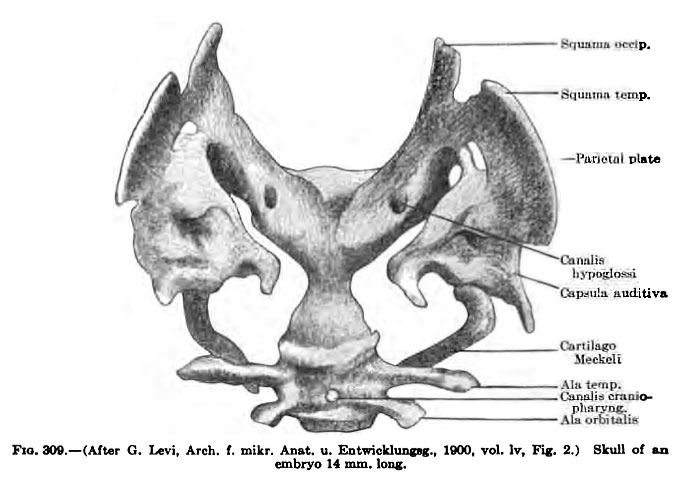File:Keibel Mall 309.jpg
Keibel_Mall_309.jpg (687 × 479 pixels, file size: 52 KB, MIME type: image/jpeg)
Fig. 309 Human Embryo Skull
Membranous skull of an embryo 14 mm long.
The tissue of the capsules of the labyrinth increases in amount as the labyrinth becomes differentiated. The tissue which encloses the region of the semicircular canals and the vestibule forms an oval mass the outlines of which do not conform to that of the enclosed canals (Fig. 309). This tissue is less dense than most parts of the membranous skeleton of the head and at an early period becomes transformed into embryonic cartilage (see p. 407). The cochlear portion of the labyrinth (Fig. 310) is enclosed by a dense mesenchyme which becomes converted into cartilage at a later period. lateral from the nasal fossa the tissue becomes generally somewhat condensed, though less so than the tissue in the septum. In the perinasal tissue condensation gradually marks out the lateral and ventral portions of the nasal capsule and the membranous floor of the ethmoidal and orbital portions of the cranial cavity (Fig. 310). From the lateral wall membranous processes project into the nasal fossa. These are the anlages of the conchae.
- KM Figure Links: The Germ Cells | Segmentation | First Primitive Segment | Gastrulation | External Form | Placenta | Axial Skeleton | Limb Skeleton | Skull | Muscular System
| Historic Disclaimer - information about historic embryology pages |
|---|
| Pages where the terms "Historic" (textbooks, papers, people, recommendations) appear on this site, and sections within pages where this disclaimer appears, indicate that the content and scientific understanding are specific to the time of publication. This means that while some scientific descriptions are still accurate, the terminology and interpretation of the developmental mechanisms reflect the understanding at the time of original publication and those of the preceding periods, these terms, interpretations and recommendations may not reflect our current scientific understanding. (More? Embryology History | Historic Embryology Papers) |
Glossary Links
- Glossary: A | B | C | D | E | F | G | H | I | J | K | L | M | N | O | P | Q | R | S | T | U | V | W | X | Y | Z | Numbers | Symbols | Term Link
Cite this page: Hill, M.A. (2024, April 16) Embryology Keibel Mall 309.jpg. Retrieved from https://embryology.med.unsw.edu.au/embryology/index.php/File:Keibel_Mall_309.jpg
- © Dr Mark Hill 2024, UNSW Embryology ISBN: 978 0 7334 2609 4 - UNSW CRICOS Provider Code No. 00098G
File history
Click on a date/time to view the file as it appeared at that time.
| Date/Time | Thumbnail | Dimensions | User | Comment | |
|---|---|---|---|---|---|
| current | 09:00, 27 August 2012 |  | 687 × 479 (52 KB) | Z8600021 (talk | contribs) | ==Fig. 309 Human Embryo Skull== Membranous skull of an embryo 14 mm long. {{Keibel_Mall Images}} Category:Human Category:Human Embryo Category:Musculoskeletal Category:Bone Category:Skull |
You cannot overwrite this file.
File usage
The following 4 pages use this file:

